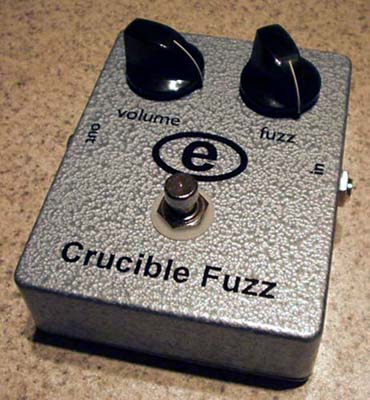
 Crucible
Reviews
Crucible
ReviewsEach unit is made by me personally, including painting, silkscreening, and wiring. It is an artisan-made guitar effect.
How does it sound? It's a fuzz box, designed to distort your signal. It's not supposed to provide “warm tube tone” or “subtle boost” or any of that. It's supposed to make your axe scream, crunch, crush, kill, and destroy. It can get those psychedelic garage tones, those wall-of-sound shoegazer tones and that singing lead Reelin' in the Years tone. It can create feedback at very low volumes.
When I started working on the design, I was shooting for early Stooges, late Hendrix, in that squalling neighborhood. My best description of what I finally achieved was that I overshot my targets. I've always been frustrated with distortion boxes that could just barely get the amount of fuzz I wanted. I wanted one that could get TOO MUCH fuzz. That's what the “Fuzz” control is there for. If there's more than you need, back it off a bit.
For those with a more technical bent, the design is closely based on the original silicon Arbiter 'Faces as resurrected by Dave Fox and marketed by Crest Audio in the late '80's. A pair of HIGH gain-selected BC109's and a tweaked bias are my “secrets.” Pots are Alpha, jacks are Switchcraft and/or Neutrik. True bypass via DPDT footswitch. True to its FF roots, the Crucible Si has no indicator LED (you will have no difficulty knowing when it is in your signal path). The circuit is optimized for operation with a 9V alkaline battery, so I do not include a power jack. If you know what you are doing, and can supply it with a clean 9V, I can be talked into installing a power jack for another $10. The finish is baked-on bluish-grey hammerite, similar to the original '60's Fuzz Faces. Logo and control markings are hand silkscreened. The knobs are bakelite Daka-Ware "stove" knobs, great for making your settings by feel on dark stages. And they look cool on lighted stages.